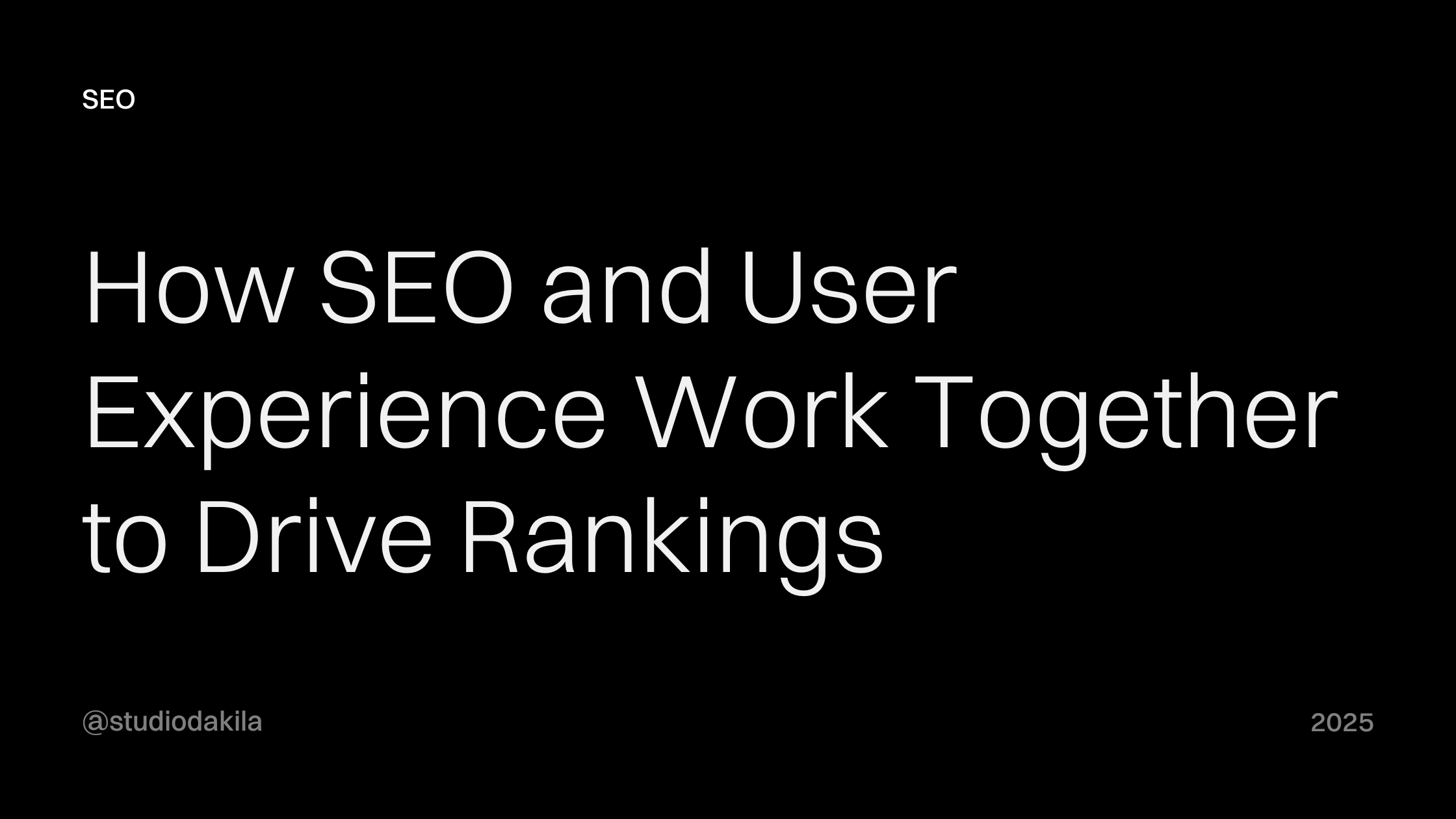Google rewards websites that users love to use. Understanding how SEO and user experience work together unlocks ranking potential most businesses never tap into.
Many businesses treat user experience and search optimization as separate concerns. But Google’s algorithms increasingly blur this line, evaluating your site through the lens of user behavior.
Think about your own search behavior. When you click a result and immediately bounce back to search, you’re sending Google a signal about that page’s quality. This exact behavior influences how your own website ranks.
Let’s explore the powerful connection between SEO and user experience, and how optimizing for users naturally improves your search performance.
Understanding the SEO and UX Partnership
User experience (UX) refers to how people interact with your website. Good UX makes these interactions positive, intuitive, and frictionless.
Search engine optimization (SEO) involves techniques that help improve your visibility in search engines.
While these might seem like separate disciplines, SEO and user experience share a fundamental goal: satisfying user needs. Google’s primary objective is delivering the most helpful, relevant results to searchers. Websites that provide excellent user experiences align perfectly with this goal.
The connection runs deep. Research shows that 88% of online shoppers are unlikely to revisit a site after experiencing poor usability. When users abandon your site quickly, Google interprets this as a signal that your content didn’t satisfy their needs.
This creates a simple truth: what’s good for users is good for search engines. Whether you’re a creative agency building client websites or an in-house team managing your brand’s digital presence, understanding this relationship is crucial.
How UX Directly Impacts SEO Performance
Google’s algorithm considers hundreds of factors when ranking websites. Many of these factors directly relate to SEO and user experience working in harmony.
Let’s examine the most critical UX elements that influence your search rankings:
Page Speed
Site speed isn’t just a technical concern. It’s a fundamental user experience factor that directly impacts SEO and UX performance.
Google reports that for every second delay in mobile page load, conversion rates can drop by 20%. This dramatic impact on user behavior directly affects how Google evaluates your site.
Slow-loading pages frustrate users, increase bounce rates, and reduce engagement. Google interprets these signals as indicators of poor quality content, potentially lowering your rankings.
Mobile Experience
We live in a mobile-first world. Mobile devices now account for over 62% of global web traffic, making mobile optimization non-negotiable for successful SEO and user experience strategies.
Google’s mobile-first indexing means the mobile version of your website is what Google primarily uses for indexing and ranking. Sites that perform poorly on mobile devices face significant ranking disadvantages, regardless of their desktop experience quality.
Responsive design, appropriate font sizes, and touch-friendly navigation aren’t just UX best practices. They’re SEO necessities that any UI UX design agency should prioritize.
Content Structure and Readability
How you organize and present content significantly impacts both user satisfaction and search performance in your SEO and user experience approach.
Clear headings, logical content hierarchy, and scannable text help users quickly find the information they need. This improved usability reduces bounce rates and increases time on page, both positive signals to Google.
Well-structured content also helps search engines better understand your page’s topic and relevance, improving your chances of ranking for target keywords.
Navigation and Site Architecture
Intuitive navigation helps users find what they’re looking for without frustration.
From an SEO perspective, logical site structure helps search engines discover and index your content more effectively. It also distributes link equity throughout your site, potentially improving rankings for deeper pages.
When users can easily navigate your site, they view more pages, stay longer, and engage more deeply. Google interprets these behaviors as signals of quality content.
UX Optimization Strategies That Boost SEO
Now that we understand the connection between SEO and user experience, let’s explore practical strategies that improve both simultaneously.
Prioritize Page Speed
Start by measuring your current performance using tools like Google PageSpeed Insights or Lighthouse.
Common speed improvements include:
- Optimizing image sizes and formats
- Implementing browser caching
- Minifying CSS, JavaScript, and HTML
- Using a content delivery network (CDN)
- Reducing server response times
Each millisecond improvement contributes to both better SEO and user experience outcomes.
Implement Responsive Design
Responsive design ensures your site functions well across all devices and screen sizes.
Key considerations include:
- Flexible grid layouts that adapt to screen dimensions
- Touch-friendly navigation and buttons
- Readable font sizes without zooming
- Properly spaced interactive elements
- Consistent experience across devices
Test your site on various devices and screen sizes to identify and fix potential issues.
Optimize Content Structure
Structure your content to satisfy both users and search engines:
Use descriptive headings that clearly indicate what each section contains. This helps users scan your content and helps search engines understand its organization.
Break text into short paragraphs with adequate white space. This improves readability, especially on mobile devices.
Include relevant visuals that enhance understanding and break up text. Just ensure they’re properly optimized for quick loading.
Use bulleted or numbered lists for series of related items to improve scannability.
Enhance Site Navigation
Intuitive navigation improves both SEO and UX:
Create a logical hierarchy that helps users understand where they are and how to find what they need.
Implement breadcrumb navigation to show users their location within your site structure. Ensure menu items use descriptive labels that clearly indicate destination content.
Include a search function for larger sites to help users quickly find specific information. Remember that every click should bring users closer to their goal, not create confusion.
Focus on Content Quality
High-quality content satisfies user intent while signaling relevance to search engines:
Create comprehensive resources that thoroughly address user questions and needs. This is especially important for SEO for B2B strategies where decision-makers need detailed information.
Use clear, concise language appropriate for your audience. Include relevant keywords naturally without sacrificing readability.
Update content regularly to ensure accuracy and freshness. Content that genuinely helps users will naturally earn longer engagement times and lower bounce rates, both positive ranking signals.
Measuring UX Impact on SEO
To understand how your SEO and user experience improvements affect performance, monitor these key metrics:
Core Web Vitals
Google’s Core Web Vitals measure real-world user experience metrics:
- Largest Contentful Paint (LCP) measures loading performance. Aim for 2.5 seconds or faster.
- First Input Delay (FID) measures interactivity. Aim for 100 milliseconds or less.
- Cumulative Layout Shift (CLS) measures visual stability. Aim for 0.1 or less.
These metrics directly influence rankings and provide clear targets for UX improvements.
User Behavior Metrics
Google Analytics provides valuable insights into how users interact with your site:
- Bounce rate indicates the percentage of single-page sessions. High bounce rates may signal poor user experience.
- Average session duration shows how long users typically spend on your site. Longer sessions generally indicate more engaging content.
- Pages per session reveals how many pages users typically view. More page views often indicate better navigation and content relevance.
Improvements in these metrics often correlate with improved search performance over time.
Mobile Usability
Google Search Console provides mobile usability reports that identify specific issues affecting mobile users. Addressing these issues improves both SEO and user experience performance.
The Virtuous Cycle of SEO and User Experience
When you improve user experience, you naturally improve SEO performance. Better SEO brings more visitors, providing more user data to further refine your UX. This creates a virtuous cycle of continuous improvement.
This approach aligns perfectly with Google’s mission to organize information and make it universally accessible and useful. By focusing on creating genuinely helpful, usable websites, you satisfy both users and search engines.
Practical Next Steps
Ready to improve both SEO and user experience? Start with these actionable steps:
- Audit your current performance using tools like PageSpeed Insights, Google Search Console, and Google Analytics
- Identify your biggest UX issues that could be affecting SEO performance
- Prioritize improvements based on potential impact and implementation difficulty
- Implement changes methodically, measuring results after each significant update
- Continue monitoring key metrics to identify new opportunities for improvement
Remember that SEO and user experience improvements compound over time. Small, consistent enhancements eventually create significant competitive advantages.
Key Takeaways
- SEO and user experience work together to create sustainable search rankings that withstand algorithm changes.
- Page speed, mobile optimization, and content structure directly impact both user satisfaction and search performance.
- Measuring Core Web Vitals and user behavior metrics helps track the success of your integrated approach.
Ready to Transform Your Digital Performance?
Don’t let poor UX hurt your search rankings. Our team specializes in creating websites that users love and Google rewards. We combine strategic SEO with intuitive design to deliver measurable results.
Frequently Asked Questions
SEO and user experience work together because Google prioritizes websites that satisfy user needs through fast loading, mobile optimization, and quality content.
Slow pages frustrate users and increase bounce rates, which Google interprets as a quality signal that can negatively impact search rankings.
Yes, positive user behaviors like longer session duration and lower bounce rates signal content quality to Google, potentially improving your rankings over time.

